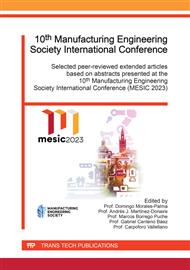p.95
p.107
p.113
p.135
p.143
p.151
p.161
p.171
p.181
Characterisation of the Performance of a Structured Light Digitising Sensor by Using Different Materials and Surface Finishes
Abstract:
The advantages of non-contact digitising systems over contact systems are undeniable. They allow capturing more information per unit of time with less accessibility problems and without alter the digitised surface. Although many of these systems have been developed with the aim of replacing contact systems in metrological verification tasks, generalist techniques such as photogrammetry, structured light, etc., have been developed over the years for digitising archaeological remains, works of art or living biological systems, among others. As is the case for non-contact measurement-oriented systems, for these generalist systems there are still difficulties in positioning them along a metrological traceability chain if they are required for any kind of measurement. This is due to the lack of specific standards, as well as the strong influence of the optical properties of the digitised surface on the quality of the results obtained. It is therefore necessary to develop calibration procedures and characterisation work to analyse this influence. The aim of this work is to characterise the metrological performance of one of these generalists structured light devices, Einscan-SP by Shining 3D, in the digitising of different calibration spheres made of different materials (WC, Al2O3, ZrO2, etc.) with different surface finishes (shot-blasted, polished, coated). As quality indicators, the number of points captured, the quality of the point cloud as well as the dimensional and geometrical deviation from the results obtained with a high-performance contact measurement system shall be used. Apart from the raw data, the influence of applying filtering to the captured clouds is analysed. The results of this work allow recommendations to be made regarding the material and finish of the spheres to be used, as well as the filtering to be applied, if necessary, in order to assess the metrological performance of this type of equipment.
Info:
Periodical:
Pages:
151-159
Citation:
Online since:
October 2023
Price:
Сopyright:
© 2023 Trans Tech Publications Ltd. All Rights Reserved
Share:
Citation:



